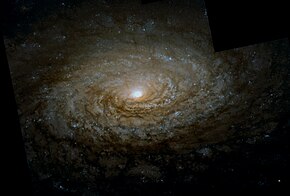| Messier 63 | |
|---|---|
 Image taken by Hubble Space Telescope, on 16 November 2001 at 450 and 814 nm[1] | |
| Observation data (J2000 epoch) | |
| Constellation | Canes Venatici |
| Right ascension | 13h 15m 49.27385s[2] |
| Declination | +42° 01′ 45.7261″[2] |
| Redshift | 484 km/s[3] |
| Distance | 29.3 Mly (8.99 Mpc)[4] |
| Group or cluster | M51 Group |
| Apparent magnitude (V) | 9.3[3] |
| Characteristics | |
| Type | SAbc[5] |
| Apparent size (V) | 12.6′ × 7.2′[3] |
| Other designations | |
| M63, NGC 5055, PGC 46153, UGC 8334[3] | |

Messier 63 or M63, also known as NGC 5055 or the seldom-used Sunflower Galaxy,[6] is a spiral galaxy in the northern constellation of Canes Venatici with approximately 400 billion stars.[7] M63 was first discovered by the French astronomer Pierre Méchain, then later verified by his colleague Charles Messier on 14 June 1779.[6] The galaxy became listed as object 63 in the Messier Catalogue. In the mid-19th century, Anglo-Irish astronomer Lord Rosse identified spiral structures within the galaxy, making this one of the first galaxies in which such structure was identified.[8]
The shape or morphology of this galaxy has a classification of SAbc,[5] indicating a spiral form with no central bar feature (SA) and moderate to loosely wound arms (bc). There is a general lack of large-scale continuous spiral structure in visible light, so it is considered a flocculent galaxy. However, when observed in the near infrared, a symmetric, two-arm structure is seen. Each arm wraps 150° around the galaxy and extends out to 13,000 light-years (4,000 parsecs) from the nucleus.[9]
M63 is a weakly active galaxy with a LINER nucleus – short for 'low-ionization nuclear emission-line region'. This displays as an unresolved source at the galactic nucleus that is cloaked in a diffuse emission. The latter is extended along a position angle of 110° relative to the north celestial pole, and both soft X-rays and hydrogen (H-alpha) emission can be observed coming from along nearly the same direction.[10] The existence of a supermassive black hole (SMBH) at the nucleus is uncertain; if it does exist, then the mass is estimated as (8.5±1.9)×108 M☉,[11] or around 850 million times the mass of the Sun.
Radio observations at the 21-cm hydrogen line show the gaseous disk of M63 extends outward to a radius of 130,000 light-years (40 kiloparsecs), well past the bright optical disk. This gas shows a symmetrical form that is warped in a pronounced manner, starting at a radius of 33,000 light-years (10 kiloparsecs). The form suggests a dark matter halo that is offset with respect to the inner region. The reason for the warp is unclear, but the position angle points toward the smaller companion galaxy, UGC 8313.[12]
The distance to M63, based upon the luminosity-distance measurement is 29,300,000 light-years (8.99 megaparsecs).[4] The radial velocity relative to the Local Group yields an estimate of 15,200,000 light-years (4.65 megaparsecs).[5] Estimates based on the Tully–Fisher relation range over 16,000,000–34,000,000 light-years (5.0–10.3 megaparsecs). The tip of the red-giant branch technique gives a distance of 28,930,000 ± 950,000 light-years (8.87 ± 0.29 megaparsecs).[13] M63 is part of the M51 Group, a group of galaxies that also includes M51 (the 'Whirlpool Galaxy').[14]
In 1971, a supernova with a magnitude of 11.8 appeared in one of the arms. It was discovered on 24 May and reached peak light around 26 May.[15] The spectrum of this, SN 1971I, is consistent with a supernova of type I. However, the spectroscopic behavior appeared anomalous.[16]
- ^ Cite error: The named reference
NASAwas invoked but never defined (see the help page). - ^ a b Cite error: The named reference
GaiaDR2was invoked but never defined (see the help page). - ^ a b c d Cite error: The named reference
nedwas invoked but never defined (see the help page). - ^ a b Cite error: The named reference
Tully2016was invoked but never defined (see the help page). - ^ a b c Cite error: The named reference
Ann2015was invoked but never defined (see the help page). - ^ a b Cite error: The named reference
Garfinkle1997was invoked but never defined (see the help page). - ^ "Messier 63 - M63 - The Sunflower Galaxy (Spiral Galaxy) | freestarcharts.com". freestarcharts.com. Retrieved 2020-06-23.
- ^ Cite error: The named reference
jonesbook1991was invoked but never defined (see the help page). - ^ Cite error: The named reference
Thornley1996was invoked but never defined (see the help page). - ^ Cite error: The named reference
Masegosa2011was invoked but never defined (see the help page). - ^ Cite error: The named reference
Graham2008was invoked but never defined (see the help page). - ^ Cite error: The named reference
Battaglia2006was invoked but never defined (see the help page). - ^ Cite error: The named reference
McQuinn2017was invoked but never defined (see the help page). - ^ Cite error: The named reference
Tikhonov2009was invoked but never defined (see the help page). - ^ Cite error: The named reference
Barbon1973was invoked but never defined (see the help page). - ^ Cite error: The named reference
Deming1973was invoked but never defined (see the help page).